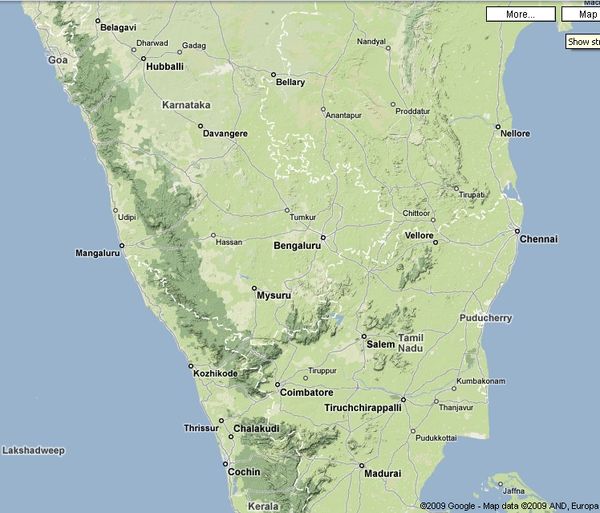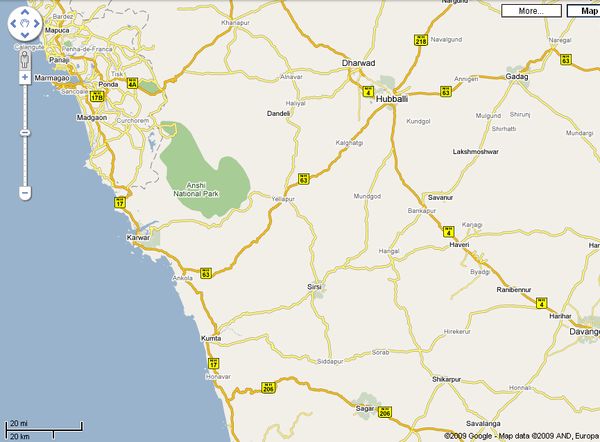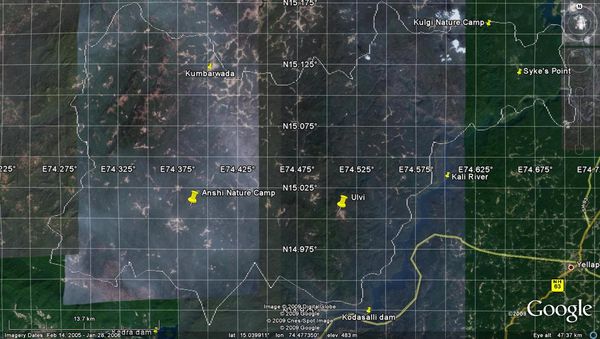| |
ENVIS Technical Report: 43, February 2012 |
 |
ECOLOGICAL STATUS OF DANDELI ANSHI TIGER RESERVE |
 |
Energy and Wetlands Research Group, Centre for Ecological Sciences,
Indian Institute of Science, Bangalore – 560012, India.
*Corresponding author: cestvr@ces.iisc.ac.in
|
|
INTRODUCTION
With 7% of world’s flora and 6.5 % of the world’s fauna spread across the 10 biogeographic zones of the nation, India constitutes one of the 10 mega biodiversity countries. The nation also boasts of two of the 34 biodiversity hotspots namely Western Ghats and Himalaya. The Western Ghats record the presence of 45 endemic plants and 73 endemic plants shared only with Sri Lanka. The Ghats form the catchment for 37 west flowing and three major east flowing rivers. With 60(%) of one of the two biodiversity hotspots of India namely the Western Ghats, Karnataka is one of the richest states of India in terms of total forest cover and has 21 wild life sanctuaries and 5 National Parks to its credit.
The District of Uttara Kannada (North Canara) - the greenest district of the state has three sanctuaries namely Dandeli Wild Life Sanctuary, Attiveri Bird Sanctuary, and Sharavathi Wild life Sanctuary and a national park (Anshi National Park). Out of the eight new tiger reserves approved by the Government of India in November 2008*, Karnataka received its fourth after Nagerhole, Bandipur and Bhadra. The Dandeli Anshi Tiger Reserve (875 sq.km) is constituted by Anshi National Park (250 sq.km, established 1987) and Dandeli Wild life Sanctuary (475 sq.km, established in the year 1956). The sanctuary includes small settlements like Kulgi, Kumbarwada, Gund, Ambikanagar,etc

Fig 1: Geographical location of Anshi Dandeli Tiger Reserve. (Source: Google map)

Fig 2. A: Location of Anshi National Park (Source: Google map)

Fig. 2.B. Google Earth Image of Dandeli Anshi Tiger Reserve with prominent land marks
Protocols for assessing the ecological status
Ecological status assessment involves the investigations of both terrestrial and aquatic ecosystems. Table 1 lists the major components and methods for assessing ecological status.
Table 1. Components of Ecological status assessment
| Terrestrial Ecosystem |
Methods followed |
| i. Land-cover and Land-use Analysis |
Slope based Vegetation indices (such as NDVI) depending on the extent of vegetation cover in the region could be used for the land-cover analysis using remote sensing data. Land-use analysis is to be done using supervised classification technique (maximum likelihood classifier). |
| ii. Vegetation Composition |
Transect cum quadrats method for sampling and the computation of the diversity indices, tree basal area, IVI, % evergreen, and % endemics and regeneration status of trees (based on girth classes) |
| iii. Faunal component |
Sampling methods differs with organism of interest, such as birds, reptiles, butterflies, tiger, leopard, etc. |
| Aquatic Ecosystem |
| i. Phytoplankton |
Sampling using phytoplankton net of mesh size 63 mm (bolting silk net No.25). |
| ii. Zooplankton |
Sampling using plankton net with mesh size 50 µm and 75 µm. |
| iii. Ichthyofauna |
Sampling using devices such as gill nets, and hooks and lines. The nets of varying mesh sizes (2 cm ´2 no., 5 cm ´2 no., and 12 cm ´1 no.) could be used in an approximate area of 200´200 sq.m. The lengths of the nets were maintained to 100 meters. The total duration of netting is 12 – 14 hours, complying with the routine practices of the fishermen. The nets are to be laid in the evenings and they are to be removed early in the morning. Shallow streams can be sampled using cast net and dragnets. |
| iv. Amphibians |
Time constrained samplings (2x2 person-hours). Amphibians will be searched using torchlight and also based on their vocal calls. |
| Humans |
| i. Socio-Economic-Energy Studies |
Questionnaire based sampling to assess the energy consumption, dependency on forest resources, livelihood aspects |
The protocols for estimating the vegetation, birds, amphibian (frogs), fish and diatoms are discussed in detail.
|
|
|
T.V. Ramachandra
Centre for Sustainable Technologies,
Centre for infrastructure, Sustainable Transportation and Urban Planning (CiSTUP),
Energy & Wetlands Research Group, Centre for Ecological Sciences, Indian Institute of Science, Bangalore – 560 012, INDIA.
E-mail : cestvr@ces.iisc.ac.in
Tel: 91-080-22933099/23600985,
Fax: 91-080-23601428/23600085
Web: http://ces.iisc.ac.in/energy
Subash Chandran M.DEnergy & Wetlands Research Group, Centre for Ecological Sciences, Indian Institute of Science, Bangalore – 560 012, INDIA.
E-mail:
mds@ces.iisc.ac.in
Rao G.R
Energy & Wetlands Research Group, Centre for Ecological Sciences, Indian Institute of Science, Bangalore – 560 012, INDIA.
E-mail:
grrao@ces.iisc.ac.in
Amit Yadav
Energy & Wetlands Research Group, Centre for Ecological Sciences, Indian Institute of Science, Bangalore – 560 012, INDIA.
Gururaja KV
Energy & Wetlands Research Group, Centre for Ecological Sciences, Indian Institute of Science, Bangalore – 560 012, INDIA.
E-mail:
gururaj@ces.iisc.ac.in
Karthick B
Energy & Wetlands Research Group, Centre for Ecological Sciences, Indian Institute of Science, Bangalore – 560 012, INDIA.
E-mail:
karthick@ces.iisc.ac.in
Uttam Kumar
Energy & Wetlands Research Group, Centre for Ecological Sciences, Indian Institute of Science, Bangalore – 560 012, INDIA.
E-mail:
uttam@ces.iisc.ac.in
Durga Madhab Mahapatra
Energy & Wetlands Research Group, Centre for Ecological Sciences, Indian Institute of Science, Bangalore – 560 012, INDIA.
E-mail:
durgamadhab@ces.iisc.ac.in
Vishnu D.M
Energy & Wetlands Research Group, Centre for Ecological Sciences, Indian Institute of Science, Bangalore – 560 012, INDIA.
Citation: Ramachandra. T.V, Subash Chandran M.D, Rao GR, Amit Yadav, Gururaja KV, Karthick B, Uttam Kumar, Durga Madhab Mahapatra and Vishnu D.M, 2012. Ecological status of Dandeli Anshi Tiger Reserve., ENVIS Technical Report : 43, Energy & Wetlands Research Group, Centre for Ecological Sciences, Indian Institute of Science, Bangalore 560 012.